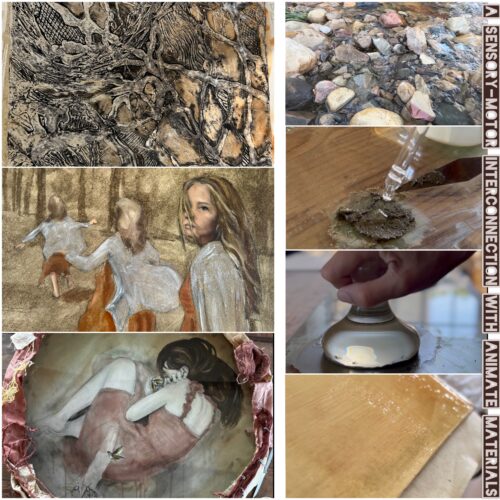
Dawn In Venice: 2
As I walked around Venice Biennale I was struck by the amount of photography on display and the variety of ways that it can be presented. The size of the images and media used to display them demonstrate the multiple personalities of photography today.

Some of the artists highlighted the material of the photographic print. For example, in the series Crush Art Chris Marker crumples and creases magazine images of women’s faces and scans them. They bring attention to something that is often overlooked when viewing photographs; that we are looking at a 2-dimensional piece of paper and not a real person. Chris Marker is most known as a film-maker, but he often uses photographs in his films. We have previously featured his La Jetée on WeAreOCA and I recommend a watch.


Some of the artwork in the exhibition considered the technology of photographic display in the digital age. Kutluğ Ataman’s installation Portrait of Sakip Sabanci forms an undulating ceiling of thousands of LCD screens showing portraits of people who were acquainted with Sakip Sabanci, a Turkish business leader and pilanthropist. The artwork was commissioned to mark the tenth anniversary of Sabanci’s death, and although it is very impressive in terms of use of technology and cost implied by it, I was unable to grasp why it was in the exhibition. Perhaps it is simply artwork for the facebook generation; thousands of identities signified by profile pictures illuminate a screen then disappear…

Samson Kambalu deserves the prize for combining the most photography presentation methods in a single display. He put images on the walls…

…in piles on a plinth…
and in a book.
This work is essentially about recycling. Kambalu photographed an archive of the Italian situationist artist Gianfranco Sanguinetti. Situationism was an intellectual movement of leftwing thinkers who opposed the impact of capitalism on everyday life. In particular they sought to counteract ‘the spectacle’ of capitalism (based on the ideas in The Society of The Spectacle written by Guy Debord) by constructing situations and ‘moments of life’ that were authentic and not driven by capitalism. In his re-conception of this work Kambalu invites the audience to re-photograph his postcards and share them on online networking sites using the hashtags #SanguinettiBreakoutArea and #biennalearte2015.
I might be a bit cynical (ok, I am definitely cynical), but the reproduction of this work in different forms; postcards, framed prints and editions of a book seems to undermine the idea of creating authentic experiences untouched by capitalist consumption. Artists like Sanguinetti often create performances rather than objects because art-objects become a commodity in the art market but performances are ephemeral – they are experienced then disappear so nobody can own them. Hasn’t Kambalu turned documents of performances into a series of commodities?
But I digress; the aim of this blog is not to critique the conceptual purity (or thinness) of a piece of artwork, and this work does say something about the way we view images today. Photographs are often taken out of their original context when they are reproduced on websites or in magazines. I frequently view images online that originally belonged in a photobook or should be printed to a specific size and hung on a gallery wall. Photographs by Andreas Gursky are a good example of this. These photographs are not big simply to look impressive and justify an equally gargantuan price tag. They have to be large so the viewer can become overwhelmed by the chaos of activity depicted.

I was reminded of this when I entered a room of Gursky’s photographs in the Biennale. The importance of scale became apparent to me when one of Gursky’s photographs seemed jarringly out of place.

May Day IV (situated on the right hand side in the image above) was dwarfed by the photographs that surrounded it.
The importance of selecting an appropriate scale was foregrounded by this experience. Often photographs are printed as large as they will go because big prints look impressive (as Geoff Dyer says in Jeff in Venice, Death in Varanasi, ‘Blow ’em up big enough and they looked … Well, they looked like shit, frankly, but they looked like art too.’ p103) but in some cases the scale has a conceptual function too.

The most effective example of this came from Edward Burtynsky’s work in the Azerbaijan Pavilion. The photographs document the use of irrigation systems in Texas. The unusual aerial viewpoint and use of very matt paper abstract the images, so they appear to be prints of geometric shapes rather than photographs.
At first I think I am looking at pattern, colour and form but on closer inspection I notice a house then a road with cars travelling along it. It is quite a shock to realise I am looking at a photograph.

The initial abstract reading makes the oddness of these irrigation systems more pronounced. The artificial manipulation of the landscape has made it unrecognisable and abstract – it is no longer ‘nature’. The content of the images and the way they are presented reinforce the environmental message of the series.
Burtynsky’s photographs encourage intellectual engagement by destabilizing my interpretation of what is going on, making me really think about the subject matter. It reminded me how important it is that the content and presentation method of any kind of artwork should be carefully selected. When this isn’t achieved the images seem gimmicky or worse – forgettable. When they are effective they are surprising, shocking and a pleasure to view.






